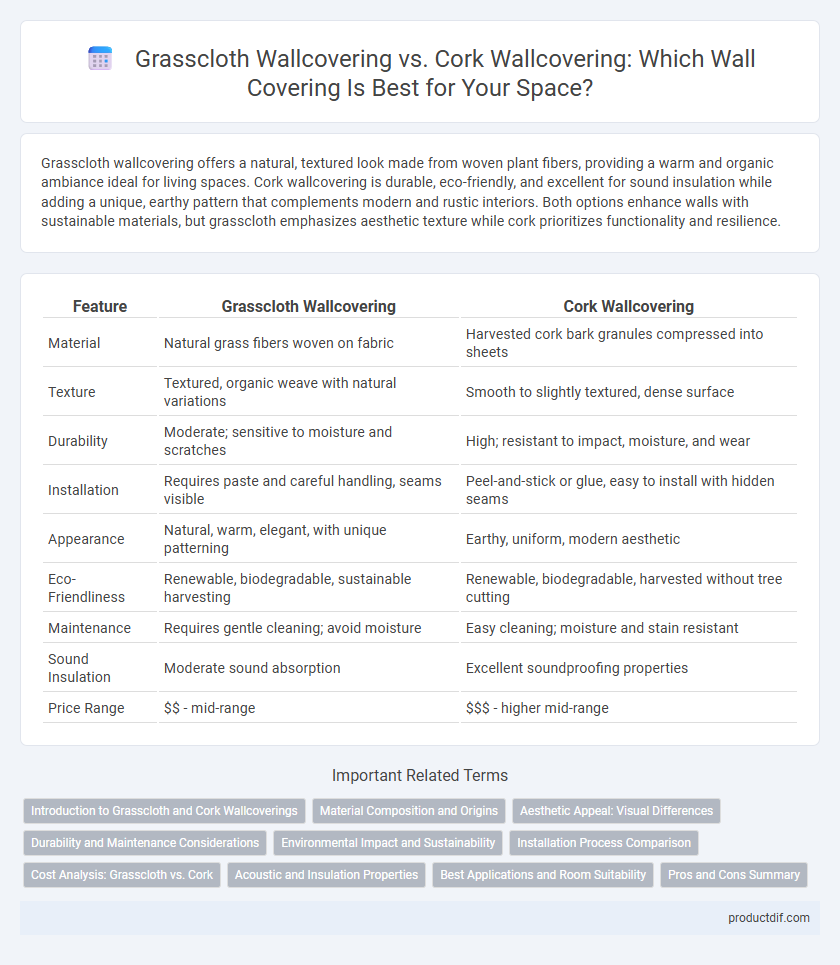Grasscloth wallcovering offers a natural, textured look made from woven plant fibers, providing a warm and organic ambiance ideal for living spaces. Cork wallcovering is durable, eco-friendly, and excellent for sound insulation while adding a unique, earthy pattern that complements modern and rustic interiors. Both options enhance walls with sustainable materials, but grasscloth emphasizes aesthetic texture while cork prioritizes functionality and resilience.
Table of Comparison
| Feature | Grasscloth Wallcovering | Cork Wallcovering |
|---|---|---|
| Material | Natural grass fibers woven on fabric | Harvested cork bark granules compressed into sheets |
| Texture | Textured, organic weave with natural variations | Smooth to slightly textured, dense surface |
| Durability | Moderate; sensitive to moisture and scratches | High; resistant to impact, moisture, and wear |
| Installation | Requires paste and careful handling, seams visible | Peel-and-stick or glue, easy to install with hidden seams |
| Appearance | Natural, warm, elegant, with unique patterning | Earthy, uniform, modern aesthetic |
| Eco-Friendliness | Renewable, biodegradable, sustainable harvesting | Renewable, biodegradable, harvested without tree cutting |
| Maintenance | Requires gentle cleaning; avoid moisture | Easy cleaning; moisture and stain resistant |
| Sound Insulation | Moderate sound absorption | Excellent soundproofing properties |
| Price Range | $$ - mid-range | $$$ - higher mid-range |
Introduction to Grasscloth and Cork Wallcoverings
Grasscloth wallcovering is a natural, textured material made from woven plant fibers such as jute, hemp, or arrowroot, offering a unique, organic aesthetic ideal for adding warmth and depth to interior spaces. Cork wallcovering, derived from the bark of the cork oak tree, provides a durable, eco-friendly option that offers sound insulation and moisture resistance, making it suitable for various applications including accent walls and ceilings. Both materials enhance interior design with their sustainable origins and distinctive textures, catering to eco-conscious homeowners and designers seeking natural alternatives to traditional wall finishes.
Material Composition and Origins
Grasscloth wallcovering is made from natural fibers such as hemp, jute, and arrowroot, handwoven into unique textures originating primarily from Southeast Asia. Cork wallcovering is composed of thin slices of cork oak bark, sourced from Mediterranean regions like Portugal and Spain, known for its renewable and sustainable harvesting process. Both materials offer eco-friendly alternatives, with grasscloth emphasizing organic fiber texture and cork providing durability and natural insulation.
Aesthetic Appeal: Visual Differences
Grasscloth wallcovering features a natural, textured weave made from woven plant fibers, offering an organic and elegant aesthetic with subtle variations and natural irregularities. Cork wallcovering presents a smooth, uniform surface with a warm, earthy tone, often displaying a more consistent pattern of small, irregular granules. The visual appeal of grasscloth is more tactile and rustic, while cork emphasizes simplicity and modern naturalism.
Durability and Maintenance Considerations
Grasscloth wallcovering offers a delicate texture that enhances aesthetic appeal but is less durable, requiring careful maintenance to avoid moisture damage and staining. Cork wallcovering provides superior durability with natural resistance to wear, moisture, and mold, making it easier to maintain through simple cleaning and occasional sealing. Choosing between grasscloth and cork depends on the balance between desired visual texture and practical longevity in high-traffic or humid environments.
Environmental Impact and Sustainability
Grasscloth wallcovering is made from natural fibers like jute, hemp, and grass, offering renewable and biodegradable properties that minimize environmental footprint. Cork wallcovering is harvested from the bark of cork oak trees without harming the tree, promoting sustainable forestry and carbon sequestration. Both options are eco-friendly, yet cork provides greater durability and water resistance, making it a longer-lasting sustainable choice.
Installation Process Comparison
Grasscloth wallcovering requires meticulous handling during installation due to its delicate natural fibers and visible seams, necessitating skilled application and precise matching of patterns. Cork wallcovering offers a more straightforward installation, often utilizing peel-and-stick backing or adhesive-based methods that allow for quicker placement and easier adjustments. Both materials demand careful surface preparation, but cork's flexible nature often results in reduced installation time compared to the intricate process involved with grasscloth.
Cost Analysis: Grasscloth vs. Cork
Grasscloth wallcovering typically ranges from $50 to $150 per roll, making it a premium option due to its handcrafted, natural fibers like jute and hemp. Cork wallcovering is more cost-effective, usually priced between $30 and $80 per roll, and offers durability and sustainability with natural bark material. Installation costs for grasscloth tend to be higher because of its delicate texture requiring skilled labor, whereas cork wallcovering is easier to install, reducing overall expenses.
Acoustic and Insulation Properties
Grasscloth wallcovering offers natural acoustic benefits by absorbing sound due to its woven texture, enhancing room acoustics without adding bulk. Cork wallcovering provides superior insulation properties, effectively reducing noise transmission and maintaining temperature by leveraging its dense cellular structure. Both materials contribute to quieter, more comfortable spaces, with cork excelling in thermal insulation and grasscloth enhancing sound absorption.
Best Applications and Room Suitability
Grasscloth wallcovering offers a natural, textured aesthetic ideal for low-moisture areas such as living rooms, bedrooms, and dining spaces, providing a soft, organic look that enhances warmth and character. Cork wallcovering excels in durability and moisture resistance, making it suitable for high-traffic areas, kitchens, and home offices where sound absorption and easy maintenance are priorities. Both materials complement eco-friendly interior designs, but selecting between them depends on room humidity levels and functional requirements.
Pros and Cons Summary
Grasscloth wallcovering offers a natural, textured aesthetic with eco-friendly appeal and excellent breathability, but it is prone to staining and can be difficult to clean. Cork wallcovering provides superior durability, sound insulation, and moisture resistance, making it ideal for high-traffic areas, though it may fade in direct sunlight and requires proper sealing to prevent damage. Both materials add unique visual interest but differ significantly in maintenance needs and application environments.
Grasscloth Wallcovering vs Cork Wallcovering Infographic

 productdif.com
productdif.com